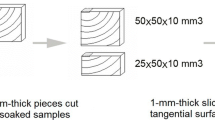Abstract
In this research, the effect of thermal modifications at 170°C, 190°C, 210°C and 230°C on the wettability of sapwood and heartwood of Scots pine (Pinus sylvestris) and Norway spruce (Picea abies) was studied by measuring the static contact angles of distilled water on the surfaces as a function of time. The results were compared to industrially kiln-dried reference samples. The thermal modification at the lower temperatures of 170°C and 190°C increased the wettability of all wood materials with the exception of the heartwood of pine that had been thermally modified at 170°C, which was the most water-repellent material in the whole study. Thermal modification at the very high temperature of 230°C was needed to decrease the wettability of wood. The differences in water repellency between sapwood and heartwood were greater for pine than for spruce.
Zusammenfassung
In dieser Studie wird der Einfluss einer thermischen Behandlung bei 170°C, 190°C, 210°C und 230°C auf die Benetzbarkeit von Splint- und Kernholz der Kiefer (Pinus sylvestris) und der Fichte (Picea abies) untersucht. Dazu wurde der statische Kontaktwinkel von destilliertem Wasser auf der Oberfläche in Abhängigkeit der Zeit bestimmt und die Ergebnisse wurden mit technisch getrockneten Kontrollproben verglichen. Bei allen untersuchten Prüfkörpern führte eine thermische Behandlung bei den niedrigeren Temperaturen von 170°C und 190°C zu einem Anstieg der Benetzbarkeit, mit Ausnahme von Kiefernkernholz bei 170°C, dem am meisten hydrophoben Holz der gesamten Untersuchung. Erst bei der höchsten Behandlungstemperatur von 230°C konnte die Benetzbarkeit von Holz reduziert werden. Bei Kiefernholz war der Unterschied in der Wasserabweisung zwischen Splint- und Kernholz größer als bei Fichte.





Similar content being viewed by others
References
Esteves B, Marques A, Domingos I, Pereira H (2007a) Influence of steam heating on the properties of pine (Pinus pinaster) and eucalypt (Eucalyptus globulus) wood. Wood Sci Technol 41:193–207
Esteves B, Domingos I, Pereira H (2007b) Improvement of technological quality of eucalypt wood by heat treatment in air at 170–200°C. For Prod J 57(1/2):47–52
Gérardin P, Petric M, Petrissans M, Lambert J, Ehrhrardt JJ (2007) Evolution of wood surface free energy after heat treatment. Polym Degrad Stab 92:653–657
Gindl M, Reiterer A, Sinn G, Stanzl-Tschegg SE (2004) Effect of surface ageing on wettability, surface chemistry, and adhesion of wood. Holz Roh- Werkst 62:273–280
Hakkou M, Pétrissans M, El Bakali I, Gérardin P, Zoulalian A (2005a) Wettability changes and mass loss during heat treatment of wood. Holzforschung 59:35–37
Hakkou M, Pétrissans M, Zoulalian A, Gérardin P (2005b) Investigation of wood wettability changes during heat treatment on the basis of chemical analysis. Polym Degrad Stab 89:1–5
Hameed M, Roffael E (1999) Über die Benetzbarkeit von Splint- und Kernholz der Kiefer, Douglasie und Lärche. Holz Roh- Werkst 57:287–293
Kocaefe D, Poncsak S, Doré G, Younsi R (2008) Effect of heat treatment on the wettability of white ash and soft maple by water. Holz Roh- Werkst 66:355–361
Kollmann FF, Côté WA (1968) Principles of wood science and technology—Solid Wood. Springer, Berlin
Kärkkäinen M (2003) Puutieteen perusteet (Principles of wood science). Karisto Oy, Hämeenlinna (in Finnish)
Metsä-Kortelainen S, Antikainen T, Viitaniemi P (2006) The water absorption of sapwood and heartwood of Scots pine and Norway spruce heat-treated at 170°C, 190°C, 210°C and 230°C. Holz Roh- Werkst 64:192–197
Nuopponen M, Vuorinen T, Jämsä S, Viitaniemi P (2003) The effects of a heat treatment on the behaviour of extractives in softwood studied by FTIR spectroscopic methods. Wood Sci Technol 37:109–115
Nussbaum RM (1999) Natural surface inactivation of Scots pine and Norway spruce evaluated by contact angle measurements. Holz Roh- Werkst 57:419–424
Pétrissans M, Gérardin P, El Bakali I, Serraj M (2003) Wettability of heat-treated wood. Holzforschung 57:301–307
Rowell RM, Banks WB (1985) Water repellency and dimensional stability of wood. General technical report FPL-50. Madison, US Department of Agriculture
Wålinder M (2002) Study of Lewis acid-base properties of wood by contact angle analysis. Holzforschung 56:363–371
Acknowledgements
The foundation of Emil Aaltonen is gratefully acknowledged for its financial support. Soili Takala and Hanna Iitti are acknowledged for their practical work and classification of the results in connection with the contact angle measurements.
Author information
Authors and Affiliations
Corresponding author
Rights and permissions
About this article
Cite this article
Metsä-Kortelainen, S., Viitanen, H. Wettability of sapwood and heartwood of thermally modified Norway spruce and Scots pine. Eur. J. Wood Prod. 70, 135–139 (2012). https://doi.org/10.1007/s00107-011-0523-5
Received:
Published:
Issue Date:
DOI: https://doi.org/10.1007/s00107-011-0523-5




